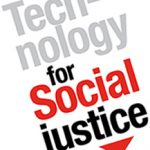On Wednesday March 21, 2012 I left the Access to Justice (ATJ) committee meeting excited about the future. Three events occurring over three (3) months spurred this.
1 – Teaching Practicum Reveal and Refreshes
My teaching practicum (TP) in Dr. Ricardo Gomez’s (University of Washington) information policy course allowed me to design and facilitate 30% (3 of 10) of the class sessions. Being the lead instructor reminded me of and revealed my strengthens & weaknesses as a lecturer/facilitator. For example, I learned that I can over use the word “cool” and that my “New York style” encouragement techniques can cause students to shut down. I was reminded that I have a good stage presence and that I can engage an audience in meaningful discussions.
2 – Technology for Social Justice
 To prepare for my third and final lecture of the quarter, I read several articles about the role of technology in promoting social justice including Donald Horowitz and Richard Zoza’s 2006 article, Washington State Access to Justice Technology Principles: A Perspective for Justice System Professionals. The article discusses the evolution of a set of principles created by legal, technology, and academic experts, in response to a May 2000 article (The Digital Divide and Digital Justice: Do Clients Need a Technology Bill of Rights) written by law librarian Jean Holcomb. The principles were developed to ensure that technology is used to encourage, not discourage access to justice (specifically the judicial system) and the chance for equal participation by everyone.
To prepare for my third and final lecture of the quarter, I read several articles about the role of technology in promoting social justice including Donald Horowitz and Richard Zoza’s 2006 article, Washington State Access to Justice Technology Principles: A Perspective for Justice System Professionals. The article discusses the evolution of a set of principles created by legal, technology, and academic experts, in response to a May 2000 article (The Digital Divide and Digital Justice: Do Clients Need a Technology Bill of Rights) written by law librarian Jean Holcomb. The principles were developed to ensure that technology is used to encourage, not discourage access to justice (specifically the judicial system) and the chance for equal participation by everyone.
After reading the article I thought, “It would be wonderful if this concept was extended to include incarcerated people!” Modified to make incarcerated groups the main focus, “Access to Justice” might include:
- shifting the conversation around the introduction of training and the accompanying networked technology in prison from one of reservation to one of belief. Belief that the Department of Correction in collaboration with other stakeholders can determine how to make this happen
- building an infrastructure that would support access and training to inmates while incarcerated so that they can be better prepared to participate in our networked society after returning
3 – Meet and Greet
The third and final factor that led me to the ATJ committee meeting was an one-on-one meeting with Mike Katell, IT Manager, Columbia Legal Services. During our conversation, I learned about Mike’s connection to ATJ and was invited to attend their March 21, 2012 meeting.
Looking Ahead
I arrived at the meeting not really knowing what to expect and left excited about the future. Why? Because….
- I was in a room filled with people interested in exploring ways of using technology to promote social justice
- I learned about other groups/people who share my interest in preparing inmates for reentry
- I heard about relevant upcoming events (e.g. the ATJ Conference)
- I discovered Donald Horowitz et al. may have data about incarcerated people’s experience with technology &
- I explained to a new group of people why prisons should proactively explore innovative ways to provide inmates with the digital literacy skills they will need when they reenter society
I am looking forward to contributing to Access to Justice’s mission. They can play a crucial role in my quest to provide one of society’s most excluded and underserved groups–prison inmates–with an environment and training that will allow them to gain the skills required for a technology-driven community.
